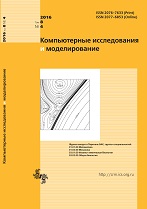|
This article is cited in 1 scientific paper (total in 1 paper)
ANALYSIS AND MODELING OF COMPLEX LIVING SYSTEMS
DNA conformational dynamics: approach to the physical mapping of genome
Yu. D. Nechipurenkoab, D. Yu. Nechipurenkob, I. A. Il'ichevaa, M. V. Golovkina, L. A. Panchenkoc, R. V. Polozovd, S. L. Grokhovskya
a Engelhardt Institute of Molecular Biology RAS, Vavilov str., 32, Moscow, 119991, Russia
b Dep. of Physics, Moscow State University, Moscow, 119992, Russia
c Dep. of Biology, Moscow State University, Moscow, 119992, Russia
d Institute of Theoretical and Experimental Biophysics RAS, Puschino, 142290, Russia
Abstract:
Recently we have developed a new method for studying DNA based on ultrasound — induced cleavage of DNA sugar-phosphate backbone. Relative cleavage rates of the phosphodiester bonds in all 16 dinucleotides have been determined. The increased amount of data sampling (of more than 20 000 nucleotides) made it also possible to obtain cleavage rates in all 256 possible tetranucleotides. These values quantitatively characterize sequence effects on conformational dynamics of DNA sugar phosphate backbone. Same type of DNA heterogeneity have been discovered and studied using its chemical cleavage induced by various chemical agents and DNAse I. The presence of essential heterogeneity in structural properties of DNA might be a key for physical mapping of the genomes, i.e. determining the structural profiles being responsible for DNA recognition by gene expression regulation machinery.
Keywords:
ultrasonic cleavage of DNA, sequence effects on DNA structure, DNA flexibility, d(CpG) dinucleotide.
Received: 15.11.2010
Citation:
Yu. D. Nechipurenko, D. Yu. Nechipurenko, I. A. Il'icheva, M. V. Golovkin, L. A. Panchenko, R. V. Polozov, S. L. Grokhovsky, “DNA conformational dynamics: approach to the physical mapping of genome”, Computer Research and Modeling, 2:4 (2010), 419–428
Linking options:
https://www.mathnet.ru/eng/crm615 https://www.mathnet.ru/eng/crm/v2/i4/p419
|

| Statistics & downloads: |
| Abstract page: | 83 | | Full-text PDF : | 45 | | References: | 18 |
|




 Contact us:
Contact us: Terms of Use
Terms of Use
 Registration to the website
Registration to the website Logotypes
Logotypes







 Citation in format
Citation in format 
